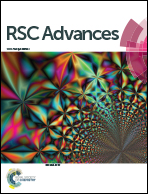A dual-faced interlayer prepared by electron beam evaporation for enhanced-performance lithium–sulfur batteries
Abstract
In this work, a dual-faced carbon paper was prepared by depositing Al2O3 on one side of carbonized filter paper via the technique of electron beam evaporation. Assembled into Li–S batteries, the Al2O3-deposited carbon paper served as a multifunctional interlayer. The cathode of 70% sulfur content with this interlayer presented notable enhancements in electrochemical performance in contrast to that with a single carbon interlayer. At a current rate of 0.5C, the battery with the Al2O3-deposited carbon interlayer delivered a high initial capacity of 1253 mA h g−1 and retention of 700 mA h g−1 over 120 cycles, while the battery with the carbon interlayer delivered an approximate initial capacity of 1117 mA h g−1 but much poorer retention of 441 mA h g−1 over 87 cycles. The carbon side of the interlayer was placed toward the cathode as the upper current collector, which ensured the conductivity of the contact interface with the active material and promoted activation of sulfur. At the same, Al2O3 as a polar material facing toward the separator impeded the leakage of soluble polysulfides and mitigated the shuttle effect by chemical adsorption of soluble polysulfides. Combined with the interstitial structure of the interlayer acting as a physical container, Li–S batteries with this novel interlayer demonstrate superiorities in capacity, variable discharge/charge rate, Electrochemical Impedance Spectroscopy (EIS) and Cyclic Voltammetry (CV) characteristics.



 Please wait while we load your content...
Please wait while we load your content...